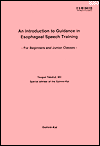An Introduction to Guidance inEsophageal Speech Training
社団法人 銀鈴会
平成11年度

CONTENTS
FRONT'S PIECES
INTRODUCTION
A. Key Points in the Guidance of Initiates
1. What Is Expected of Instructors
2. Explanation to New Students
3. Discussing Individual Operations
4. Types of Postlaryngectomy Speech
5. Principles of Esophageal Speech
6. Mental and Physical Conditions of Students
7. Advantages to Learning Esophageal Speech
8. Encouraging Beginners to Vocalize
9. Dealing with Different Levels of Skill
10. Good Posture
B. Practical Program for Beginners
1. Practice Producing the Basic Sound
2. Tea-Drinking Method
3. Structure and Functions of the Esophagus
4. Function of the Diaphragm and Abdominal Respiration
5. How to Ingest and Expel Air
○ Injection
○ How to expel air
○ Inhalation
○ Mixed method
6. Hyperventilation Syndrome
7. Sequence and Steps of Exercises
C. Training in Esophageal Speech and Notes for New Students
1. Breathing Practice and Speech Production in Conversation
2. Concerns During Practice
(1) Noises from the tracheostoma
(2) Speaking under tension
(3) Avoiding injected or inspirated sound
(4) Avoiding sounds caught in saliva
(5) Other undesirable sounds
3. Nasal Resonance (Reforming of Nasal-Congested Speech)
4. Oral Whispering
5. Producing "Ha" Sounds
6. People on the Right Track to Fluency
7. Speech Training for Those Undergoing Esophageal Reconstruction
D. Questions and Answers for New Students
Summing Up
Program of the esophageal speech training
−How to Speak again−
I. INTRODUCTION
II. HOW TO PRACTICE ESOPHAGEAL SPEECH SOME ADVICE
III. WHEN YOU PRACTICE
IV. PRACTICAL EXERCISES
V. EXERCISES IN VOWELS
VI. EXERCISES IN CONSONANTS
VII. POLYSYLLABIC WORDS; SIMPLE CONVERSATION
VIII. EXERCISES IN ACCENT (STRESS AND PITCH)
IX. SYNTHETIC TRAINING
(1) Clearness (High Intelligibility)
(2) Loudness (Volume)
(3) Fluency
(4) General harmony
X. PERIODS OF PRACTICE
XI. CONCLUSION
ADVICE FOR IMPROVING ESOPHAGEAL SPEECH
PREFACE
I. THE REGION OF VOCALIZATION
II. THE VERIFICATION OF THE REGION OF UTTERANCE
III. INHALATION METHOD
IV. ABOUT HIGH TONES
V. SPECIFIC TECHNIQUES OF HIGH TONE VOCALIZATION
VI. A VIEW ON HIGH TONE VOCALIZATION
VII. TO SING A SONG
VIII. POINTS ON ESOPHAGEAL SPEECH
IX. POINTS ADVANCED TRAINEES SHOULD BE AWARE OF
X. INSTRUCTION TO CORRECT WRONG ESOPHAGEAL SPEECH
XI. CASE STUDIES
成果物の著作権に関するご注意